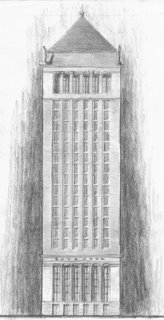If a Tree Falls in a City - East 12th Street

While not breaking news, the absurdity of the changing East 12th streetscape above (absent the central median trees) certainly deserves a few sentences on The Design Rag. The above image, taken yesterday morning, shows progress made towards the redesign of East 12th Street in anticipation of the Avenue District development between 12th and 13th Streets.
From an August 28th article by Steven Litt in Cleveland's Plain Dealer:
"Architect Paul Volpe of City Architecture, who is designing a $150 million complex of new loft and townhouse buildings in the area, obtained preliminary 'conceptual' approval earlier this summer from the Cleveland Design Review and City Planning committees to tear out the medians, cut down the trees and replace them with wider sidewalks shaded by new trees."
What will this new stretch of 12th St. between Superior and Chester look like?
Scott from Cleveland vs. The World notes a few details from the August 4 Cleveland Planning Commission meeting (Scott's site is a great resource for checking out the goings-on at each Planning Commission meeting):
"DRC 06-031: Reserve Square, Streetscape Improvements, East 12th Street Streetscape Plan, final approval.
Features angled parking, removal of median and bike path."
In addition to removing mature trees that provide a continuous broadleaf canopy over East 12th St. (will these trees will be replaced with sickly honey locusts spaced thirty feet apart??), the streetscape plan will introduce angled parking on a heavily traveled bus route (nearly a dozen buses during rush hours). Will the suburban planning principals of angled parking (easy to park, and more cars per linear foot of street) give cars ownership over East 12th? Ironically, the decisions to remove the central median, widen already wide sidewalks, and provide more parking on East 12th which were meant to provide a better pedestrian experience, will likely have the opposite effect. Crosswalk distances across traffic lanes will be wider (due to median removal), angled autos will compete for curb space with frequently stopping and passing buses, and deeper sidewalks with fewer trees will intensify the presence of the brutal concrete Reserve Square behemoth.
Of course, the completed streetscape engaged in everyday city-life will be the best indicator of its advantages for street-level retail or pedestrian safety and enjoyment. However, I suspect that this is an exercise in over-planning and a poor project for investing City $$ and resources for failing infrastructure (hardly failing and hardly more deserving than half of Cleveland's city streets).






